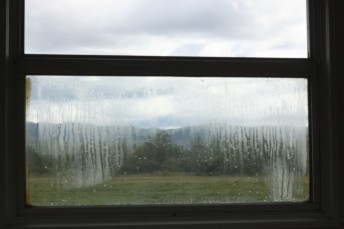If you've noticed condensation forming on or inside your windows, you're not alone. Homeowners across Louisiana, Mississippi, and Alabama frequently deal with foggy glass and water droplets. In our hot, humid, and storm-prone climate, moisture inside windows is a common issue—but one that can point to bigger problems with insulation, air leaks, or aging windows.
Whether you're seeing temporary fog or persistent haze between panes, understanding what's causing the issue is essential. Some condensation is harmless. Other times, it signals that your windows are no longer protecting your home as they should.
Here’s what causes moisture to appear inside your windows, when it’s normal versus concerning, how it impacts your home, and how LAS windows are designed to eliminate the problem altogether.
What Causes Moisture Inside Windows?
Most window moisture stems from condensation—the process where water vapor in the air turns into liquid when it encounters a cooler surface. But condensation is just one possible explanation. Understanding the root cause helps determine whether your windows need simple ventilation adjustments or full replacement.
Indoor Humidity and Everyday Activities
In the Gulf South, our homes naturally have higher humidity levels than in other parts of the country. When that warm, moist air encounters a cooler windowpane, condensation forms.
Cooking, showering, laundry, and even breathing all release moisture into the air. Homes that are tightly sealed for energy efficiency may trap this moisture inside unless ventilation is addressed. Bathrooms, kitchens, and laundry rooms are common hotspots for condensation because of how much humidity these areas generate.
Seasonal Temperature Differences
The clash between indoor and outdoor temperatures plays a big role in condensation. During winter, the inside of your home stays warm while the outside air cools. That cold exterior causes the inner glass surface to drop in temperature. When your warm indoor air touches that chilly glass, water droplets may appear on the inside of the window.
In summer, the reverse can happen—especially with well-insulated windows. Cold interior air conditioning cools the window, and when hot, humid outdoor air touches the exterior, condensation can form on the outside. In most cases, exterior condensation isn’t a problem—it’s actually a sign your windows are insulating well.
Poor Insulation or Leaky Windows
Older windows, especially single-pane models, transfer air more easily as they are not as good insulators as newer double-pane windows. In our climate, this can introduced abnormal humidity inside your home which will lead to a more conducive environment for surface condensation.
Additionally, compromised seals, gaps in caulking, or deteriorated weatherstripping can allow humid outdoor air or even rainwater to sneak inside the window assembly. In a region with frequent heavy rains and storms, even small leaks can introduce water that appears as condensation on or near your windows.
Is It Condensation or a Broken Window Seal?
Not all moisture means something’s wrong—but some types of moisture signal window failure. Knowing how to spot the difference can help you avoid unnecessary repairs or, conversely, catch a serious problem before it causes damage.
Temporary Surface Condensation
If you see moisture on the interior surface of your window—especially after cooking or showering—it’s likely just surface condensation. This type of moisture typically:
- Appears in the morning or after high-humidity activities
- Wipes away easily with a cloth
- Disappears with ventilation or time
It’s common in homes with high indoor humidity or insufficient airflow. If it’s occasional and isolated, it’s usually not a cause for concern.
Persistent Condensation Between Panes
Moisture trapped between the glass panes of a double-pane window is a different story. These windows are designed with an insulated seal that keeps an inert gas (like argon) between the panes to improve energy efficiency. If the seal fails, that gas escapes, and humid air seeps in.
Over time, you may notice:
- A cloudy or foggy appearance that doesn’t go away
- Water droplets or streaks between the panes
- White mineral deposits or haze that worsen over time
This type of fogging won’t clear with ventilation or cleaning. The only way to fix a failed seal is to replace the insulated glass unit.
Water Leaks and Frame Moisture (Not Glass Condensation)
If you notice moisture that appears as actual water—such as pooling on the window sill or dripping down the window frame—and it’s not forming on the surface of the glass itself, this likely indicates a leak, not normal condensation.
This type of water infiltration, especially after rain, may result from:
- Failed or deteriorated caulking or flashing around the window
- Cracked or damaged frame components
- Water intrusion through surrounding walls or siding
Unlike interior condensation that forms on glass due to temperature differences, these leaks signal structural or installation issues and should be addressed promptly. Left unchecked, they can lead to mold growth, wood rot, and even long-term damage to your home’s structure.
Why It Matters: The Risks of Window Moisture
Even if foggy glass seems like a cosmetic issue, persistent moisture can lead to real problems. Over time, moisture inside your windows affects your comfort, your energy bills, and your home’s condition.
Obstructed Views and Aesthetics
One of the main reasons we install windows is to let in light and provide a view. But when glass is clouded by condensation or haze between panes, those benefits disappear. Fogged windows:
- Block natural light
- Obscure your view outdoors
- Create a neglected appearance from the outside
For homeowners thinking of selling, visibly fogged windows can lower curb appeal and raise red flags for buyers or inspectors.
Structural Damage
Over time, repeated exposure to moisture can wear down the materials that surround your window. Paint may peel. Wood may swell, crack, or rot. Drywall and trim can absorb water and crumble. If condensation turns to leaks, you could even face water damage beneath the window, inside the wall cavity.
Indoor Discomfort
Humidity doesn’t just affect your windows—it impacts how your home feels. High moisture levels indoors can make the air feel muggy in summer and damp or chilly in winter. Your HVAC system must work harder to maintain a comfortable temperature, often leading to higher energy bills and uneven comfort.
How LAS Windows Prevent Moisture Problems
At LAS, we design and install windows specifically built for the demands of Gulf Coast climates. Our moisture-resistant vinyl windows help homeowners fight back against fog, leaks, and energy loss.
Here’s what sets LAS windows apart:
Double-Pane Insulated Glass
All LAS windows feature sealed double-pane glass with an argon gas fill. This creates a thermal barrier that resists condensation and keeps the interior glass temperature closer to the air inside your home—reducing the chances for fogging.
Low-E Glass Coatings
Low-E (low emissivity) coatings reflect heat and UV rays while improving energy efficiency. They help maintain a consistent glass temperature and reduce the contrast between indoor and outdoor air—one of the key triggers of condensation.
Moisture-Resistant Vinyl Frames
Unlike wood or metal, vinyl won’t rot, rust, or corrode. Our multi-chambered vinyl frames provide additional insulation and are built to custom measurements for each window opening. During installation, we use:
- Triple-lined felt weatherstripping
- High-performance caulking
- Properly installed weep holes to drain incidental moisture
This ensures a tight, weatherproof seal from day one.
Built for Gulf Coast Conditions
Our WeatherGard vinyl windows are designed, tested, and manufactured with our climate in mind. Whether it's intense humidity, driving rain, or sudden temperature swings, LAS windows are made to perform. They also meet Energy Star® and impact resistance standards, giving homeowners peace of mind during storm season.
Expert Installation
A high-quality window can only perform well if it’s installed correctly. Our trained installation crews follow best practices for waterproofing, sealing, and drainage. That means you won’t need to worry about hidden leaks or poor fits that can let moisture in.
Proactive Tips to Prevent Window Moisture
Even with well-made windows, a few smart habits can go a long way in keeping condensation at bay:
- Use exhaust fans when cooking or showering to remove humid air.
- Open windows briefly on cooler, dry days to air out the house.
- Avoid blocking airflow by keeping curtains or blinds slightly open.
- Clean window weep holes and tracks to ensure proper drainage.
- Inspect caulking and weatherstripping annually and re-seal as needed.
- Use a dehumidifier if your home tends to feel damp or if you spot frequent condensation.
- Replace or repair windows that show signs of seal failure, rotting frames, or chronic fogging.
If your windows are simply too old or underperforming, no amount of dehumidifying will fully solve the problem. That’s when a full window replacement is often the best solution.
Schedule a Free Consultation
Tired of wiping away condensation or living with foggy glass? LAS can help. We’ve been building and installing high-performance windows for Gulf Coast homes for decades. Our team can assess your current windows and recommend whether a repair, insulated glass replacement, or full window upgrade is right for you.
Clear views, lower energy bills, and a drier, more comfortable home are just one consultation away.








